How are New Yorkers adapting how they interact with and move about New York City during the novel coronavirus pandemic?
Background
Prior to COVID-19, NYC & Company, the official destination marketing organization (DMO) and convention and visitors bureau (CVB) for the five boroughs of New York City, stated their mission was: “to maximize travel and tourism opportunities throughout the City, build economic prosperity and spread the dynamic image of New York City around the world.”
While New York City is currently experiencing the worst outbreak of Novel Coronavirus in the United States, their mission has evolved from focusing on bringing tourists into the city to understanding how residents are responding to the pandemic and helping local businesses with digital campaigns.
New Yorkers are adapting to COVID-19
The Big Apple all but shut down when Gov. Cuomo began enforcing the shelter in place order on March 18, 2020. Since then, New Yorkers’ daily routines have drastically changed. One thing is clear: New Yorkers are shifting and adapting how they interact with and move about our city
By utilizing Vista’s human movement data, NYC & Company has built a dashboard dedicated to understanding the impact COVID-19 has had on visitation to parks during the city’s lockdown.
Methodology
New York City Daily Park Activity Dashboard by NYC & Company represents the number of unique mobile devices captured in 25 different New York City Public Parks located in all 5 boroughs from January 28, 2020 to April 10, 2020. Public parks were classified as either tourist, neighborhood, or business parks.
A tourist park, like Central Park, is a destination that visitors to the City will often visit. Neighborhood parks, like Fort Greene Park, are tucked into neighborhoods and typically visited by residents that live nearby. Business parks, like Bryant Park, are surrounded by businesses in New York City and are popular lunch spots for professionals during the work day.
Why parks?
New York City is a city of many things, but above all it is a place where people gather to live, work, and visit. A consistent touch point between residents, tourists, and commuting professionals is City Parks. Parks offer a place for fresh air, room to exercise, and more in an otherwise crowded and bustling city.
Insights
Park visitation overall is down

Source: https://public.tableau.com/profile/nyc.company#!/vizhome/PublicParkActivity/Dashboard1
Since Gov. Cuomo declared New York’s “Shelter in Place” order on March 18, 2020, park visitation overall is down. There is a peak in visitation after NYC’s first confirmed case of COVID-19 on March 9, 2020, when the weather reached a high of 72 degrees.
Additionally, many businesses, like NYC & Company, began working from home the week of March 13, sending commuters home and away from their popular work week lunch spots.
Tourist parks are seeing less visitors, but more locals
After the first confirmed case of COVID-19 in NYC on March 9, visitation to Central Park in Manhattan decreased dramatically across the board.
The distribution of visitors by Borough also changed dramatically. Prior to COVID-19, the majority of visitors (49%) were from “Outside 5 Boroughs,” meaning they were non-locals and travelers visiting the park, and 29% of visitors were from Manhattan.
After the “Shelter in Place” order on March 18, 52% of visitors were from Manhattan and only 24% of visitors were non-locals.
Tourist Parks: Visitation to Central Park Before COVID-19
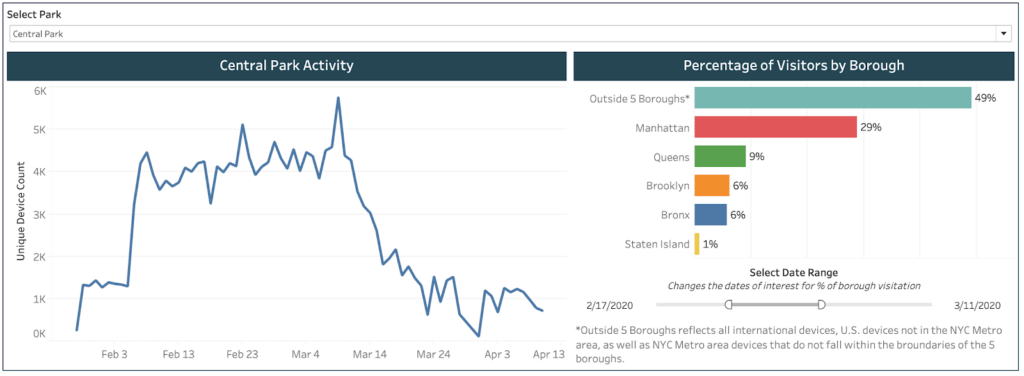
Source: https://public.tableau.com/profile/nyc.company#!/vizhome/PublicParkActivity/Dashboard1
Tourist Parks: Visitation to Central Park After COVID-19
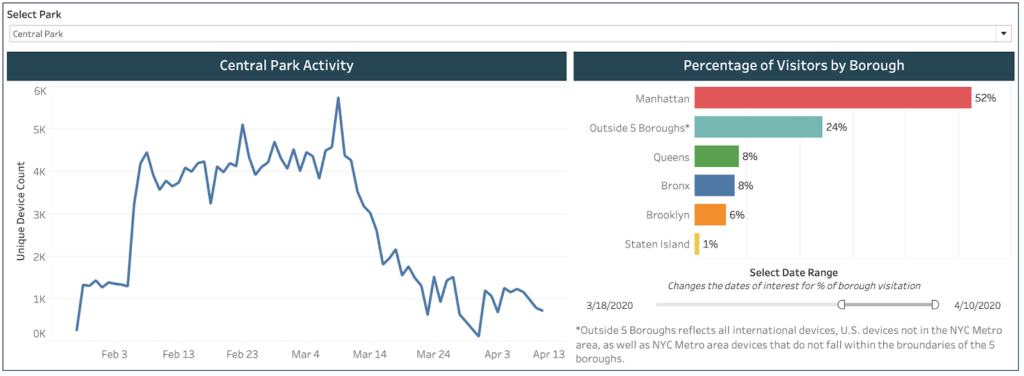
Source: https://public.tableau.com/profile/nyc.company#!/vizhome/PublicParkActivity/Dashboard1
Popular “work lunch” locations are still seeing some visitors, mostly non-locals
When looking at parks surrounded by Manhattan businesses, visitation overall has decreased. The distribution of visitors, however, has stayed fairly consistent, with the majority of visitors being non-locals. This suggests that these parks are respites for essential workers that still need to travel into Manhattan for their jobs.
Business Parks: Visitation to Bryant Park Before COVID-19
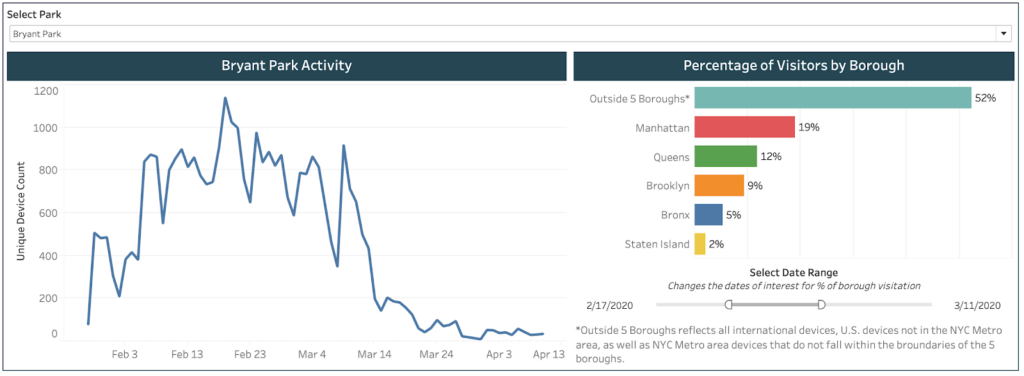
Source: https://public.tableau.com/profile/nyc.company#!/vizhome/PublicParkActivity/Dashboard1
Business Parks: Visitation to Bryant Park After COVID-19

Source: https://public.tableau.com/profile/nyc.company#!/vizhome/PublicParkActivity/Dashboard1
Neighborhood Parks
Neighborhood parks, like the Fort Greene park in Brooklyn, are typically visited by residents living nearby. That fact, overwhelmingly, is displayed in the data. Prior to COVID-19, 69% of visitors were from Brooklyn. After the pandemic, that jumped to 80% of visitors.
Visitation to the park has not seen as dramatic of a drop in visitation as tourist and business parks, likely due to the nature of neighborhood parks: New Yorkers are finding ways to exercise, get fresh air, and unwind in the green spaces near their homes.
Neighborhood Parks: Visitation to Fort Greene Park Before COVID-19
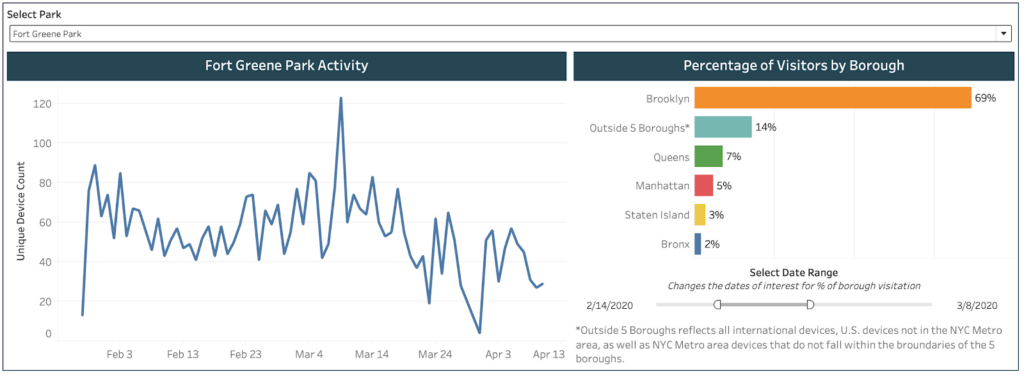
Source: https://public.tableau.com/profile/nyc.company#!/vizhome/PublicParkActivity/Dashboard1
Neighborhood Parks: Visitation to Fort Greene Park After COVID-19
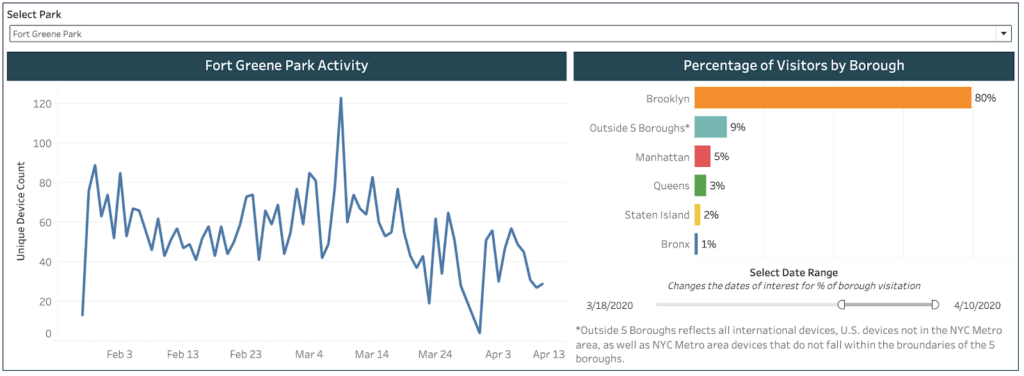
Source: https://public.tableau.com/profile/nyc.company#!/vizhome/PublicParkActivity/Dashboard1
About NYC & Company:
“NYC & Company is the official destination marketing organization for the five boroughs of New York City. Our mission is to maximize travel and tourism opportunities throughout the City, build economic prosperity and spread the dynamic image of New York City around the world.”




